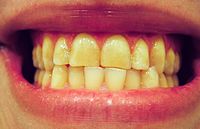
Photo from wikipedia
Objectives It is not clear whether dopaminergic medication influences bruxism behaviour in patients with Parkinson’s disease (PD). Therefore, the aims are to investigate (i) the prevalence of possible (i.e., self-reported)… Click to show full abstract
Objectives It is not clear whether dopaminergic medication influences bruxism behaviour in patients with Parkinson’s disease (PD). Therefore, the aims are to investigate (i) the prevalence of possible (i.e., self-reported) bruxism (sleep and awake) in PD patients, and (ii) whether the use of dopaminergic medication and other factors (viz., demographic characteristics, PD-related factors, and possible consequences of bruxism) are associated with possible bruxism (sleep or awake). Materials and methods This study concerns a secondary analysis of an earlier published study. Three hundred ninety-five PD patients (67.9 ± 8.6 years of age; 58.7% males) were included. The levodopa equivalent daily dosage (LEDD) was used as a measure of the dopaminergic medication level. Subsequently, a logistic regression analysis was performed for the dependent variables ‘awake bruxism’ and ‘sleep bruxism’, with the following predictors: gender, age, LEDD, time since PD diagnosis, temporomandibular disorder (TMD) pain, jaw locks, and tooth wear. Results The prevalence of possible awake and sleep bruxism was 46.0% and 24.3%, respectively. Awake bruxism was associated with sleep bruxism (OR = 8.52; 95% CI 3.56–20.40), TMD pain (OR = 4.51; 95% CI 2.31–8.79), and tooth wear (OR = 1.87; 95% CI 1.02–3.43). Sleep bruxism was associated with tooth wear (OR = 12.49; 95% CI 4.97–31.38) and awake bruxism (OR = 9.48; 95% CI 4.24–21.19). Dopaminergic medication dose was not associated with awake bruxism (OR = 1.0; 95% CI 0.99–1.00) or sleep bruxism (OR = 1.0; 95% CI 0.99–1.00). Conclusion Bruxism is a common condition in PD patients, but is not associated with the dopaminergic medication dose. Clinical relevance (Oral) health care providers should be alerted about the possibility of sleep and awake bruxism activity in PD patients, along with this activity’s possible negative health outcomes (viz., TMD pain, tooth wear).
Journal Title: Clinical Oral Investigations
Year Published: 2020
Link to full text (if available)
Share on Social Media: Sign Up to like & get
recommendations!